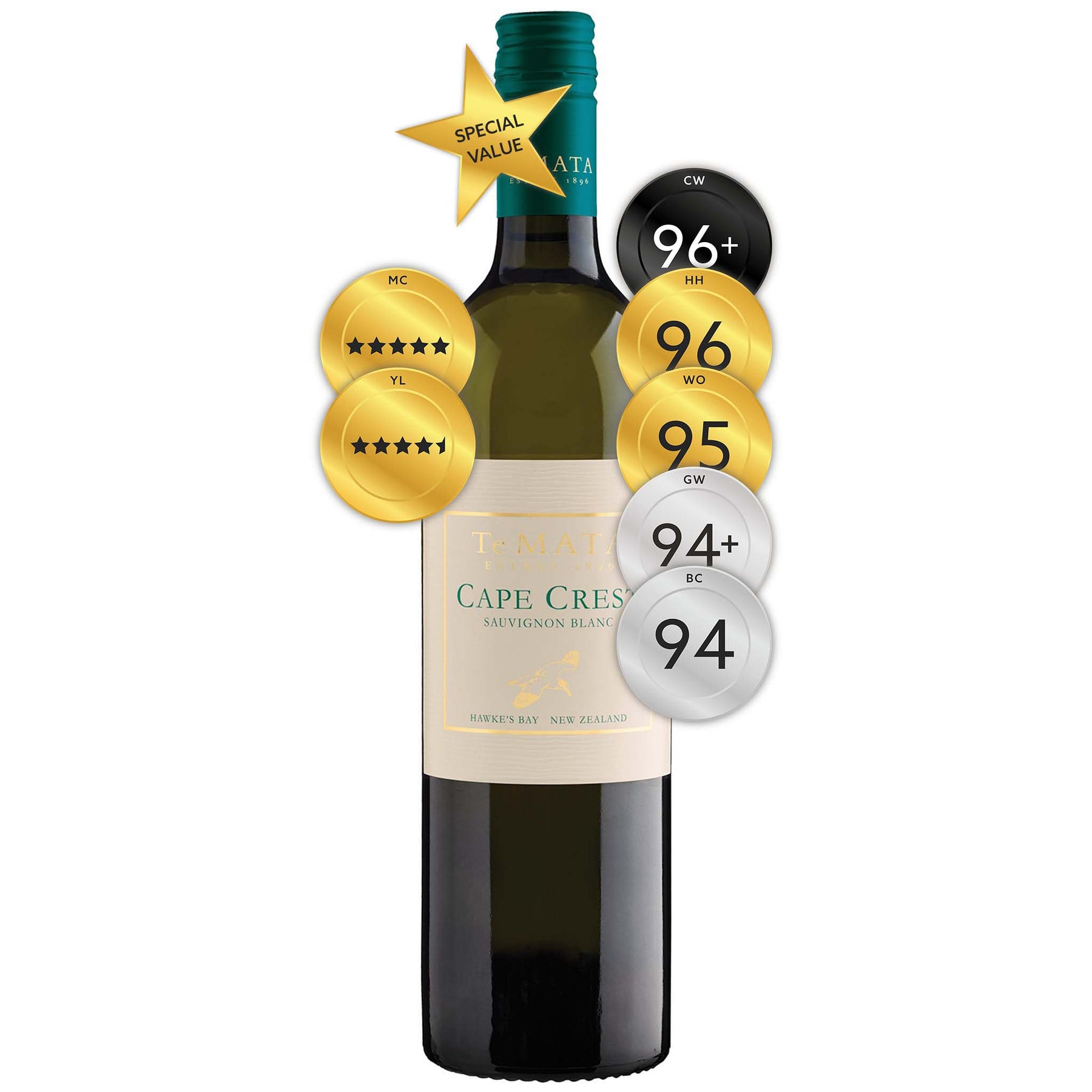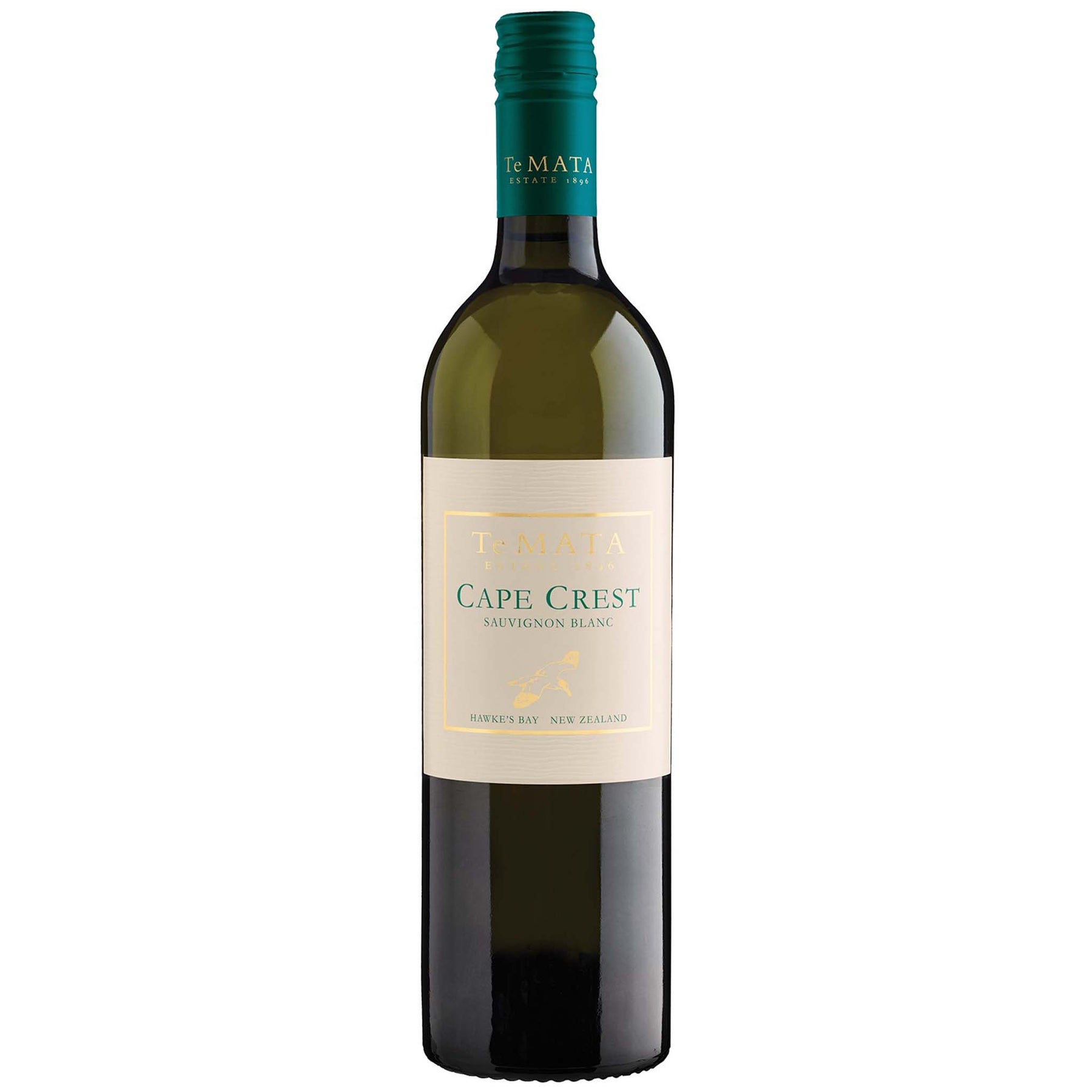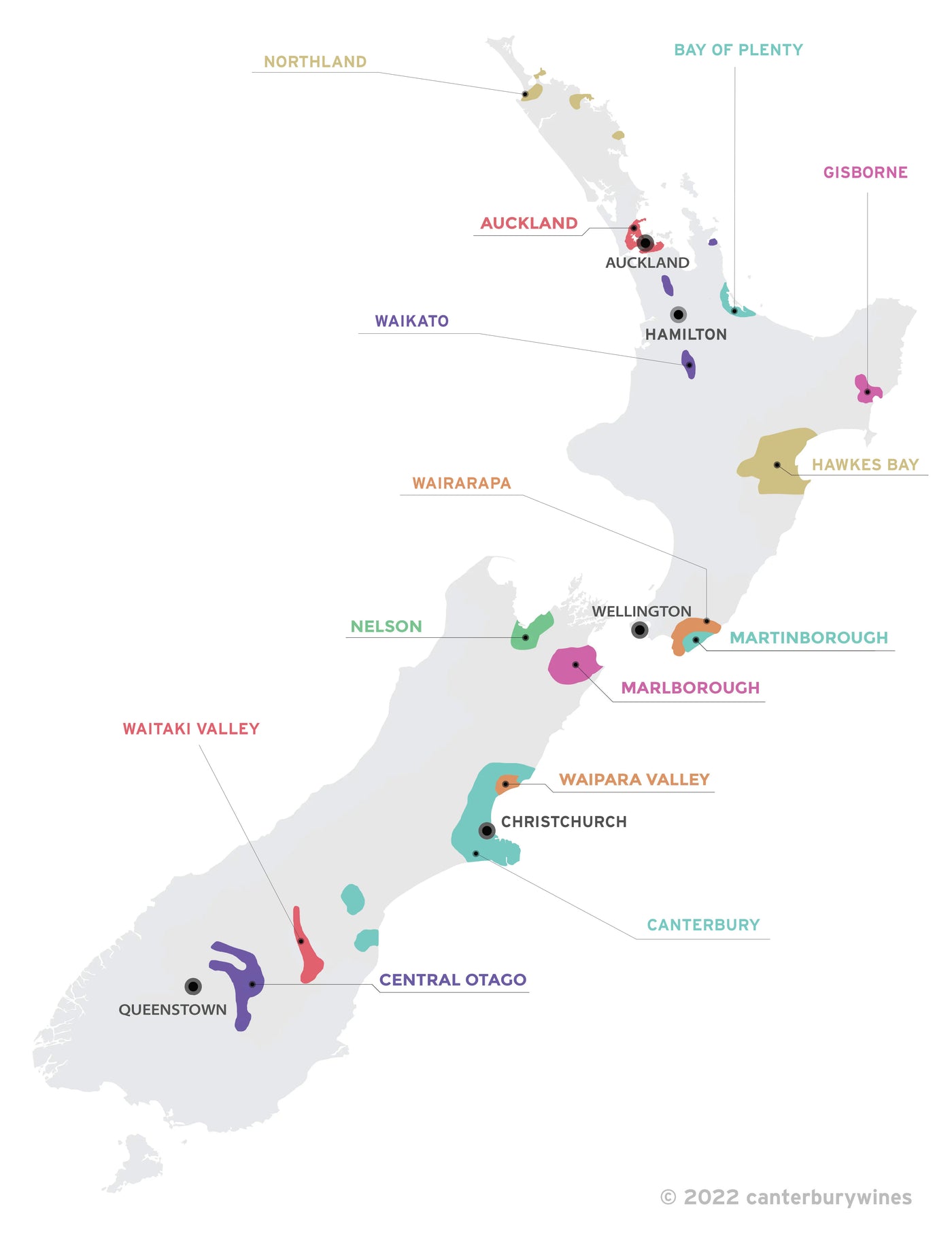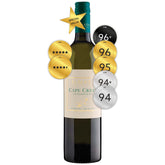

Te Mata Estate Cape Crest Sauvignon Blanc 2020
Style: White Wine
Closure: Screwcap
Te Mata Estate Cape Crest Sauvignon Blanc 2020
Warehouse
34 Redland Drive
Vermont VIC 3133
Australia
Critic Score: 96 and ★★★★★
Alcohol: 13.0%
Size: 750 ml
Drink by: 2035
"Te Mata's Cape Crest aligns with the Bordeaux model of dry, oak-influenced, ageworthy Sauvignon Blanc – and absolutely bears comparison with the great whites of Pessac-Léognan and Graves." Richard Hemming MW
The 2020 Cape Crest is a blend of predominantly Sauvignon Blanc (85%) with small quantities of Semillon and Sauvignon Gris that was fermented and matured in French oak barriques for 11 months. The fruit comes from the Isosceles vineyard in the Bridge Pa subregion which was planted in 1990 and 2000. To quote Richard Hemming MW, "The result is a lip-smacking combo of butter, cream and spice that comes from from the oak and malolactic conversion, alongside box-fresh citric fruit and leafy notes that are the hallmarks of the variety."
"The wine is very intense in the mouth, concentrated and powerful, with tremendous length and a very even line, assisted by vibrant acidity. An impressive style." Huon Hooke
"The 2020 is a remarkable Cape Crest; palest lemon and brilliant in the glass. Luscious citrus and succulent stone fruit slide effortlessly towards a precise and lingering finish of gooseberry, lime and sea salt. Among all the ripe and pure fruit on the palate floats crunchy acidity and complexing grace-notes of dill, coriander, beeswax and woodsmoke. Cape Crest Sauvignon Blanc '20 is a signature example, with drive, moreish appeal and elegance to spare." Te Mata Estate
Te Mata Estate Winery
Expert reviews
"Let me be upfront and admit that I'm not a great fan of Sauvignon Blanc. So when I attended a luncheon recently that showcased the recent Te Mata releases, including the 2020 Coleraine, I can't say I was too excited when the first wine up was the Cape Crest Sauvignon Blanc (which I had not tasted before). Silly me - it was a glorious wine! The palate is incredibly intense, fresh and juicy with a backbone of vibrant acididity, but complexed by the barrel maturation which adds wonderful creaminess, spices and oak nuances to the flavours. I can't wait to see what this looks like in 5 to 10 years time." Nick Munday, Canterbury Wines - 96+ points and Special Value Wine ★
"Light, bright yellow-straw hue, with a pungent lemon zest and burnt-lime aroma, nutty and spicy reflections, with extra dimensions added by barrel fermentation, although it's hard to identify overt oak character. The wine is very intense in the mouth, concentrated and powerful, with tremendous length and a very even line, assisted by vibrant acidity. An impressive style. Drink 2022-2032." Huon Hooke, The Real Review - 96 points
"Fabulously composed and expressed with Granny Smith apple, lemon/lime peel, white floral and oatmeal characters, it's juicy and wonderfully flavoursome in the mouth delivering excellent fruit purity and intensity with a subtle savoury/saline nuance. Brilliantly structured and super long on the finish. At its best: now to 2033." Sam Kim, Wine Orbit – 95 points
"This oak-aged Hawke's Bay label is impressive for its ripely herbal, complex, sustained flavours. Most of the grapes are hand-picked in the company's relatively warm Bullnose Vineyard, inland from Hastings (the rest is grown at Woodthorpe, in the Dartmoor Valley), and the blend includes small proportions of Sémillon (to add longevity) and Sauvignon Gris (which contributes weight and mouthfeel). The wine is fully fermented and lees-aged for eight to eleven months in French oak barriques (partly new). The lovely 2020 vintage is invitingly scented, full-bodied and very savoury, with rich peach and passionfruit flavours, enriched by biscuity oak, a suggestion of herbs, lively acidity and a dry, lasting finish. Drink now or cellar." Michael Cooper Buyer's Guide to New Zealand Wines ★★★★★
"A screwcap! My kingdom for a screwcap. 85% Sauvignon Blanc, 9% Semillon and 6% Sauvignon Gris. 30% new oak. Gooseberry, matchstick, passionfruit pith and leaf, fennel. Tight, gooseberry, lime and grapefruit, fine mineral things happening here, chalky and dusty texture, precision and freshness, intense, with very good length, and layer of subtle creaminess and spiced oak. A calmer, more confident expression of Sauvignon in 2020. A fair bit of bottle age will see it improve further, I feel. Drink: 2022 - 2029+." Gary Walsh, The Wine Front - 94+ points
"One sip and you'll see straight away how this wine has become an absolute aristocrat in sauvignon blanc circles. Gorgeously golden in the glass, it's crafted from a blend of 85% sauvignon blanc, 9% semillon and 6% sauvignon gris which is gently fermented in a mixture of new and seasoned French oak barrels which adds flesh and complexity. It was then aged on its lees, and stirred regularly for 11 months to create a wine scented with smoked lemongrass, soft basil, beeswax and magical marzipan. On the palate, it shows precision, supple lines and deep, lingering textures to finish. Love it." Yvonne Lorkin ★★★★(★)
"Te Mata are best known for their reds, especially the much-admired Coleraine Bordeaux blend, but when tasting their range recently it was Cape Crest that stood out for me. Not only are the flavours both utterly delicious and wholly representative of an underrated style, but it also has a beguiling waxiness that would make it an ideal partner for many types of dish. I can imagine it holding up equally well to seafood salads, creamy sauces, or even local lamb cooked with Moroccan spices.
The 2020 vintage is a blend of 85% Sauvignon Blanc, 9% Sémillon and 6% Sauvignon Gris, fermented and matured in French oak barriques (of which 30% were new) for 11 months, which is very much the traditional recipe for the style. The result is a lip-smacking combo of butter, cream and spice that comes from from the oak and malolactic conversion, alongside box-fresh citric fruit and leafy notes that are the hallmarks of the variety." Richard Hemming MW, jancisrobinson.com
"A blend of sauvignon blanc 85%, semillon 9% and sauvignon gris 6%. Fermented and matured in oak for 11 months. Richly textured, bone-dry wine with oak and nutty yeast lees quite prominent, although the slightly grassy varietal character is clearly evident. A classy wine. Drink 2022-2026." Bob Campbell, The Real Review - 94 points
Awards
Special Value Wine – Canterbury Wines ★
About Cape Crest
 Nick Buck discusses Te Mata Estate Cape Crest (click on image to play video)
Nick Buck discusses Te Mata Estate Cape Crest (click on image to play video)
The following article by Richard Hemming MW appeared in jancisrobinson.com
Most Sauvignon Blanc from New Zealand follows a tried-and-tested formula, and while its global popularity seems undimmed there are few that appeal to the highly engaged wine drinker. But not all Sauvignon Blancs are made equal; you say tomato, I say Te Mata.
Rather than the Marlborough model of gooseberries and grassiness, Te Mata's Cape Crest aligns with the Bordeaux model of dry, oak-influenced, ageworthy Sauvignon Blanc – and absolutely bears comparison with the great whites of Pessac-Léognan and Graves.
The 2020 vintage is a blend of 85% Sauvignon Blanc, 9% Sémillon and 6% Sauvignon Gris, fermented and matured in French oak barriques (of which 30% were new) for 11 months, which is very much the traditional recipe for the style. The result is a lip-smacking combo of butter, cream and spice that comes from from the oak and malolactic conversion, alongside box-fresh citric fruit and leafy notes that are the hallmarks of the variety.
Te Mata are best known for their reds, especially the much-admired Coleraine Bordeaux blend, but when tasting their range recently it was Cape Crest that stood out for me. Not only are the flavours both utterly delicious and wholly representative of an underrated style, but it also has a beguiling waxiness that would make it an ideal partner for many types of dish. I can imagine it holding up equally well to seafood salads, creamy sauces, or even local lamb cooked with Moroccan spices.

The fruit comes from their vineyards in the Bridge Pa subregion, pictured above, which were planted in 1990 and 2000 – relatively recent considering Te Mata's first vines were planted in 1892. The name Cape Crest, incidentally, is a reference to the most southerly point of Hawke's Bay, home to a colony of gannets, one of which adorns the label. The first vintage was 1984 and this wine was, most unusually for a New Zealand white, bottled exclusively under cork until the 2020 vintage – very bordelais!
I asked the team at Te Mata about this and senior winemaker Phil Brodie responded: 'We have gone to screwcap with Cape Crest from the 2020 vintage. The winemaking finishes the day the customer opens the bottle. We love Cape Crest in its youth, but also with bottle age. We have our own bottling line and started a screwcap closure trial 15 years ago looking at different screwcap brands having different wad compositions with varying oxygen transmission rates (OTRs). We then analysed and tasted the wines over the years to see how they evolved aromatically and texturally before committing to a particular brand and wad.'
Commercial sales manager Vince Labat adds, 'We went with a 50/50 screwcap/cork mix for vintage 2020 and 2021. We are transitioning some markets across to the screwcap who have long had the cork. Hence taking this approach. It has been well accepted so as of the 2022 vintage it will be 100% screwcap.'
Te Mata's own cellaring guide suggests the wine can last for 20 years – and I wouldn't disagree. Great oaked Sauvignon Blanc is certainly one of the few great white wines that can benefit from maturity, so don't let age dissuade you.
About the winery

Te Mata Estate was established in 1896, specialising in high-quality wines of classical style. The winery remains family owned, producing internationally recognized wines exclusively from its Hawke's Bay vineyards.
"New Zealand's first growth" - Andy Howard MW, Decanter Magazine
"A national treasure" - Jancis Robinson MW
"New Zealand's greatest winery" - Robert Parker's Wine Advocate
Te Mata Estate was originally part of Te Mata Station, a large pastoral land-holding established by English immigrant, John Chambers, in 1854. After returning from France, John Chamber's third son, Bernard, had the idea to plant vineyards on the north-facing hills around Havelock North. In 1892 he planted vines on three parcels of hillside land above the homestead and began converting the original stables to ferment and mature the wines. The first vintage wines were released in 1986. Today, Te Mata Estate still uses those same three vineyards.
The Chambers family sold the property in 1919. The property had two other owners until John and Wendy Buck acquired Te Mata Estate in 1978 and instigated a twenty-year development program, which commenced with the restoration of the original winery building and the replanting of all of the original vineyards. In addition, new vineyard sites were acquired in the Bridge Pa, Gimblett Gravels and Dartmoor Valley sub-regions of Hawke's Bay (refer map below). The Buck family have been producing Te Mata wines ever since. The success of Te Mata's wines in the '80s is credited with sparking the revival of Hawke's Bay as a top wine region.

Te Mata Estate Winery and Hawke's Bay sub-regions

New Zealand
New Zealand is home to more than 700 wineries across 14 wine regions. The regions are Auckland, Bay of Plenty, Canterbury, Central Otago, Gisborne, Hawkes Bay, Marlborough, Martinborough*, Nelson, Northland, Waikato, Waipara Valley, Wairarapa and Waitaki Valley. * Martinborough is a sub-region of Wairarapa, however, as it is world renowned it is considered here to be a region to avoid confusion.
The wine regions in New Zealand stretch from latitudes 36°S (Northland) in the north (comparable in latitude to Jerez, Spain), to 45°S (Central Otago) in the south (comparable in latitude to Bordeaux, France). New Zealand's climate is maritime, producing cooler summers and milder winters than would be expected at similar latitudes in Europe.
Viticulture in New Zealand dates back to 1836 when British resident James Busby produced wine in the far north, but it wasn't until 1985 that the wine industry came of age when Cloudy Bay Sauvignon Blanc garnered international attention and critical acclaim.
New Zealand is internationally renowned for Sauvignon Blanc (particularly from Marlborough), Pinot Noir (Central Otago, Martinborough and Waipara Valley), Chardonnay, Bordeaux-style blends of mainly Merlot and Cabernet Sauvignon (Hawkes Bay) and Syrah (Hawkes Bay). Sauvignon Blanc accounts for 63% of the area of the national vineyard, followed by Pinot Noir (14%), Chardonnay (8%), Pinot Gris (7%) and Merlot (3%).


